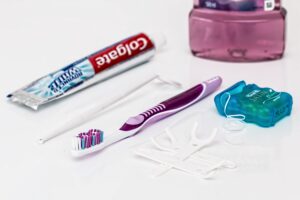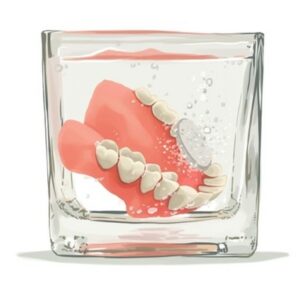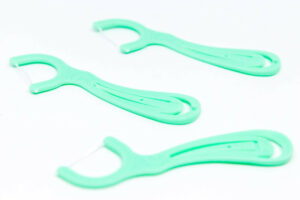An essential, but often overlooked part of daily personal care is oral hygiene. It involves cleaning of the client’s mouth, teeth and/or dentures. Oral hygiene removes debris (which can harbor microorganisms), stimulates circulation, reduces unpleasant odors, and improves tastes of foods.
Depending upon your client, you may only need to assist them in doing oral hygiene, or you may need to provide total oral hygiene care. Performing or assisting with oral hygiene is an important task of the HCA. Oral hygiene should be performed at least twice per day, with morning and evening care. Oral hygiene may also be performed after eating meals and any time the client requests. Regular, daily flossing helps remove plaque and food debris, which promotes bacteria, from the client’s mouth. Unclean mouths harbor bacteria, which can cause additional health problems for the client. Having a clean mouth promotes a sense of comfort and self-esteem for the client, and improves the overall taste of food.
Providing oral care also gives HCAs an opportunity to observe the health of the client’s teeth, gums, and tongue. HCAs should encourage their clients to independently perform as much of their oral care as possible. For clients who are unable to grasp the handle of a toothbrush, special toothbrushes may be available for them. A split rubber ball or tape can be used to build up the handle of the toothbrush to make it easier for the client to hold. An electric toothbrush may also be used. Avoid using hydrogen peroxide or alcohol-based products, because they promote mouth irritation and mucosal membrane breakdown. For some clients, using a toothbrush may be unsafe, such as those who are unable to spit or who are unconscious. For these patients, special mouth swabs are available for use. Oral care should be provided every two hours for clients who are unconscious. or unable to drink. the client’s lips to prevent skin breakdown, chapping, and drying of the lips.
Assisting Clients with Oral Hygiene
Table 4.2.1 Procedure: Patients Who Can Brush Their Own Teeth or Need Some Assistance
| STEP | ACTION | REASON |
| 1. | Explain the procedure to the client. Provide privacy. | For client to know what to expect. |
| 2. | Wash and dry hands. Always wear gloves when providing oral care. | Infection prevention and control. |
| 3. | Assemble equipment. You will need:
|
 |
| 4. | Ensure the client is in an upright position for safety. If the client is able to brush their own teeth, provide equipment and assist as needed. | A high sitting position prevents choking or aspiration. |
| 5. | Wet the toothbrush and apply a small amount of toothpaste to the bristles on the brush. | Too much toothpaste is unnecessary for good oral hygiene and a wet toothbrush helps to lubricate the toothpaste. |
| 6. | Hold the toothbrush at a 45-degree angle to the gum line. Brush one tooth at a time in an up and down motion. Start from the top of the gum line and work down the tooth. | The angle helps the bristles to reach under the gum line. |
| 7. | Start at the upper teeth and then complete the lower teeth. | |
| 8. | To clean biting surfaces of teeth and the tongue, use a back-and-forth motion. | |
| 9. | Be sure to brush all surfaces of the teeth, gums, tongue, and mouth. | |
| 10 | Ensure the client adequately rinses their mouth with clean water and dries their lips and face. | |
| 11. | Offer lip and/or mouth moisturizer as needed, and according to the client’s preferences. | Makes the client feel refreshed and tastes of foods pleasant. |
Watch the following video, How to help with tooth brushing, by CareChannel (2019) on YouTube. CareChannel was developed by the Saint Elizabeth Foundation. Presented by Elizz. Funded by The Ontario Ministry Of Health Long Term Care. For details, visit: http://elizz.com/carechannel
Patients Who Are Unable to Perform Mouth Hygiene Independently
| STEP | ACTION | REASON |
| 1. | Complete hand hygiene and assemble needed equipment. | |
| 2. | Put the client in a side-lying position. Turn their head to the side. | To prevent possibly choking or aspiration. |
| 3. | Place a towel or waterproof pad under their cheek and chin to prevent the client or bed linens from getting wet. | |
| 4. | Place an emesis or kidney basin against the side of their mouth and cheek. | Can catch liquid and secretions. |
| 5. | Open the client’s mouth by placing gentle pressure on their chin and upper mouth. Use a second toothbrush, such as the type in Figure 4.2.1, or place a padded tongue depressor to help keep the client’s mouth open and prevent them from biting down. To make a padded tongue blade, place two wooden tongue blades together. Wrap gauze over the top half and tape it into place. | Never put your fingers inside their mouth because the client may bite down, even if they do not mean to.

|
| 6. | Brush teeth gently, using a dry toothbrush or a mouth swab. Dip the swab in water and squeeze the excess solution from the swab. Swab all surfaces of their teeth, gums, inside their cheeks, the roof of their mouth, and their tongue. Use clean swabs as necessary. |
Suction excess secretions as directed in the Care Plan.
|
| 7. | Rinse the client’s entire mouth with a clean swab. Ensure there are no pooled secretions. | To prevent potential for aspiration (chocking). |
| 8. | Ensure the client’s mouth, face, and neck are dry. | Prevents skin breakdown. |
| 9. | Apply moisturizer to lips and/or mouth. | Client comfort. |
| 10. | Return the client to a comfortable position. Lower the bed to its lowest height and raise the side rails. | Client safety. |
| 11. | Put away your equipment and supplies. | Good work practices. |
| 12. | Remove your gloves and wash and dry your hands. | Infection prevention and control. |
| 13. | Document the completion of the task and record any changes in condition or behavior. Report any tooth or mouth conditions observed, such as sores, open areas, or bleeding from gums, tongue, or broken teeth. | Good communication between care providers. |
Denture Care
Table 4.2.3 Procedure: Dental Care
| STEP | ACTION | REASON |
| 1. | Complete hand hygiene and assemble needed equipment. |

|
| 2. | Assist the client to remove dentures, if needed, by placing a tissue, gauze pad, or washcloth underneath the client’s denture line and gently pulling forward to break the suction. You may need to gently rock the dentures from side to side or forward to break the suction. | |
| 3. | Carefully place dentures in a water filled cup or container. |
 |
| 4. | Carry the dentures to the sink using a denture cup. | To prevent accidental breakage. |
| 5. | Place a towel in the sink while you are washing them. Hold them firmly. | This will prevent you from accidentally breaking dentures on the hard surface of the sink. |
| 6. | Clean dentures as you would teeth. Use denture cleaning products. Use warm, but not hot water. Rinse dentures completely. | Hot water can cause dentures to warp and no longer fit the client correctly.
 |
| 7. | Provide or assist with mouth care prior to replacing dentures. Assist the client to brush their gums and tongue with toothpaste and a toothbrush. Ensure they rinse their mouth completely. Offer alcohol-free mouthwash. | Alcohol-based mouthwash can be drying and increase irritation. |
| 8. | If returning dentures to the client’s mouth, apply denture cream or adhesive, as needed. | Client preference |
| 9. | Assist the client to place the dentures back in their mouth. To reinsert dentures, insert at an angle, pressing firmly onto the gum line. | To ensure a good fit. |
| 10. | If storing dentures, store them in clean, cool water in a container with a closed top. | To prevent accidental breaking or misplacement. If in a facility, ensure the client’s name is on the denture cup to prevent loss or confusion. |
| 11. | Remove your gloves. Wash and dry your hands. | Infection prevention and control. |
| 12. | Document the completion of the task and record any changes in the client’s condition or behavior. Report any tooth or mouth conditions you’ve observed, or if dentures are broken or missing. | Good communication between care providers. |
Watch this video, Denture Care (How to Care for Someone’s Dentures) by CareChannel (2019) on YouTube.
Flossing Your Client’s Teeth
Table 4.2.4 Procedure: Flossing
| STEP | ACTION | REASON |
| 1. | Complete hand hygiene and assemble needed equipment. | |
| 2. |
|
 |
| 3. | Hold the floss tightly between your thumb and forefingers. Starting at the top and back of the mouth, guide the floss between two teeth. Use a gentle rubbing motion to guide the floss between the teeth. | Do not quickly snap the floss between the teeth, or you can cause pain or injury. |
| 4. |
|
|
| 5. | Repeat for each tooth, using a clean section of floss for every 1–2 teeth. | |
| 6. | Allow the client to rinse and dry their mouth. Dispose of floss. Do not reuse floss. | |
| 7. | Remove your gloves. Wash and dry your hands. | Infection prevention and control. |

